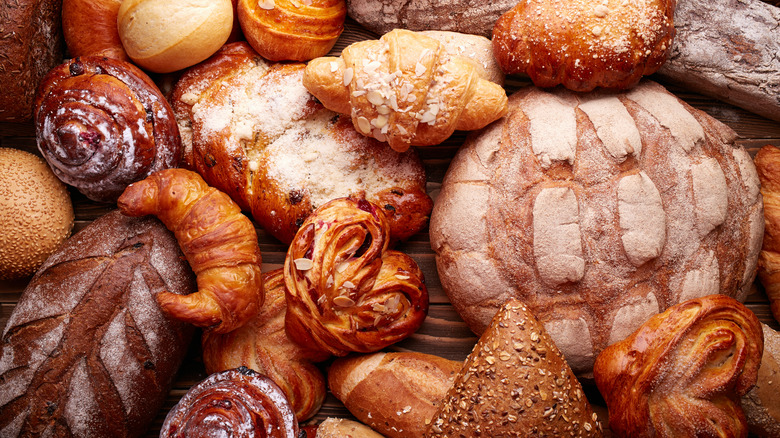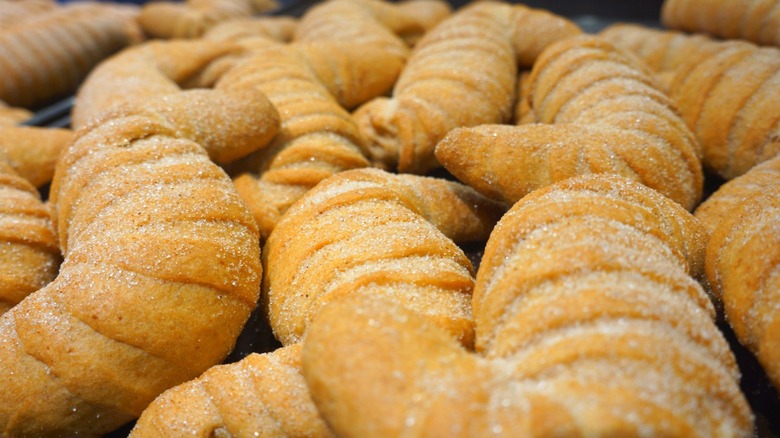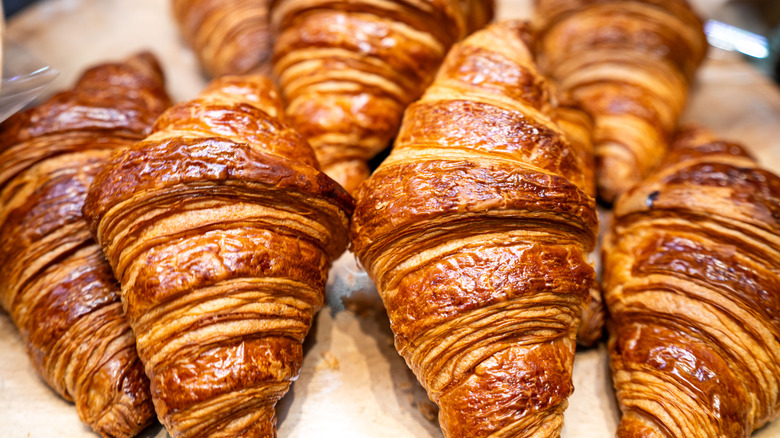Bigotes Vs Croissants: What's The Difference?
Despite looking the same at first glance, bigotes and croissants each have a unique smell, taste, and texture. Croissants are French pastries that are made with laminated dough, which is why they're so flaky. While bigotes appear related, they are Mexican pan dulces (Spanish for "sweet breads") and don't have a laminated dough. Instead, they're made with Danish-like dough to create a softer texture that's still flaky but not as flaky as croissants.
Although the process of making bigote dough is less involved than croissants, shaping the breads still involves cutting and wrapping thin triangles into swirl-like shapes. This process is why they look so similar at a glance. But, if you look closely, you'll see that their forms are distinguishable. Croissants have a more distinctive, crescent moon–like shape while bigotes are straighter, like mustaches. In fact, bigote is the Spanish word for "mustache."
Additionally, you'll be able to tell bigotes from croissants because they are brushed with melted butter when they come out of the oven and coated with granulated sugar. Croissants, on the other hand, have a shiny, glossy exterior because they're given an egg wash before baking.
Learning more about bigotes
In the 16th century, Spaniards brought pan dulce to Mexico when they introduced wheat to the country. However, it wasn't until the French occupation in the 19th century that pastry-making became an art in Mexico, with the native chefs developing a taste for the delicious items that French bakers were producing. This led to innovation in Mexican baking in the early 20th century, which was highly supported by Mexico's former president Porfirio Díaz. Many colorful and flavorful pastries were created with the addition of native fruits and vegetables, raw sugar, vanilla, and chocolate.
The dough for bigotes is prepared by mixing flour, salt, sugar, and yeast together with cold chunks of butter until it becomes a coarse meal. Eggs, milk, and vanilla are added before chilling the dough for a few hours. Then, the dough is folded and put back in the fridge overnight before it's shaped and baked. It's important that the butter remains intact until it melts in the oven, leaving small air pockets to create layers. While covering bigotes in sugar after baking is traditional, you can adjust the topping to your liking and enjoy them with cocoa powder, cinnamon, lime zest, fruit powder, or chocolate syrup.
Getting to know croissants
It's believed that French croissants have origins in the Austrian pastry kipferl, which has been around since at least the 13th century. After an Austrian artillery officer established a bakery in Paris in the mid-19th century, Parisian bakers started imitating his kipferl and calling the bread "croissant," which means "crescent" in French, because of its shape. However, the first official recipe didn't emerge until the early 20th century, at which point croissants rose in popularity. With the recipe's evolution over the years, this bread has become undeniably French.
Croissants are made with yeasted, laminated dough, a process that involves repeatedly incorporating butter into the folds of the dough. The dough is also chilled in the refrigerator for several hours before it's cut and rolled into the classic crescent shape and topped with egg wash, keeping the butter cold so that it melts in the oven. This result is a crisp, shiny outside and an airy, tender inside that can be enjoyed with savory fillings like ham and spinach or with sweet fillings like chocolate or fruit. You can even make grilled cheese on a croissant.


